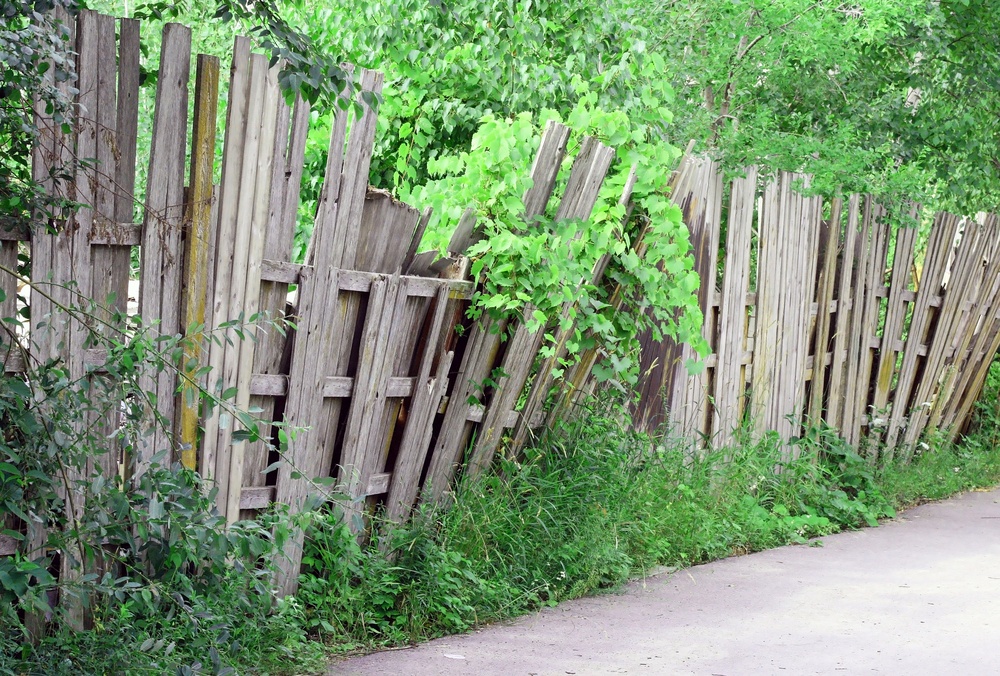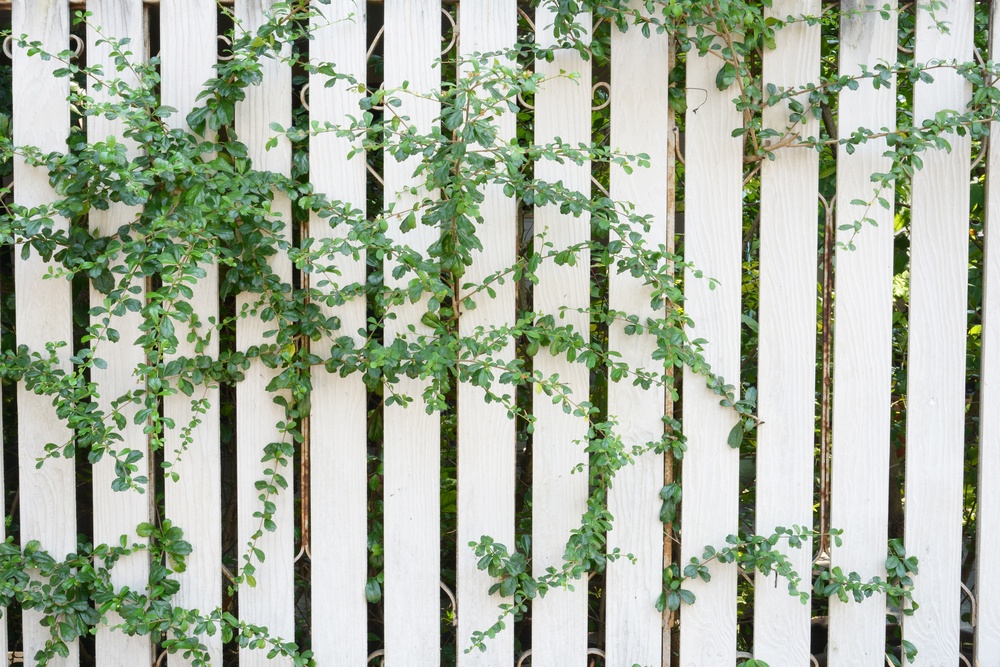Growing Fence-Friendly Vines: Do’s and Don’ts
Has your fence already been damaged by vegetation? Are you in the market for a new one? If you live near West Chester, PA and the Delaware Valley, you’re in luck! Request a quote for professional fence installation.
A structure covered in vines is one of the most classic and beautiful features you can add to your backyard. Vines climbing a fence not only enhance aesthetic value but make your yard more private. Unfortunately, vines can be as destructive as they are beautiful. They’re resourceful plants that crawl up structures in order to soak up as much sun as they can, and sometimes they hold on tight and bring the structure down. You need to make sure your fence is suitable for vines and also that you’ve chosen a vine that won’t cause damage. So, if your dreams have been full of sprawling ivy, not so fast! Here are some do’s and don’ts to consider before growing vines on your backyard fence.
Vines that Aren’t Fence-Friendly
The types of vines that are most likely to be unfriendly to your fence and your outdoor living space are fast-growing, woody vines and invasive species of vines. Though many of these are beautiful, such as hydrangea or English ivy, they can destroy your fence and shouldn’t even come near it.
Woody Vines
Some woody vines are favorites of gardeners for good reason. Many of them, like wisteria or trumpet vine, bloom with bright, fragrant flowers that attract hummingbirds or butterflies. However, when these vines begin to spread over your wooden fence’s surface, they hold excess moisture against the wood. This opens the door for rot as well as fungus, bugs, and other hazards that can wreak havoc on your fence. The “wood” part of the woody vine’s anatomy can also cause a problem: the vine’s strong wooden roots can get between the slats of a wooden fence or into existing cracks and cause breakage, especially on moisture-softened wood. Rapid-growing woody vines in particular can therefore spell disaster for your fence.
Invasive Species
Many a hapless homeowner has introduced a beautiful vine to their fence, and a short time later, they ended up fighting an ongoing war with a vine that turned out to be a member of an invasive species. Invasive species of vines are often related to native species, like American bittersweet’s relative oriental bittersweet. These unwelcome cousins of naturally-occurring vines have been known to overtake entire geographic regions, choking out ecosystems and individual gardens alike. Invasive species like the chocolate vine, English ivy, wintercreeper, and Japanese honeysuckle pose a hazard not only to the environment but to the appearance of your outdoor space.
All of the problems that come with growing woody vines on your fence (the moisture and accompanying structural damage) are compounded by invasive species’ tendencies to grow rapidly on every inch of available space. This includes your fence, lawn, other plants and trees, and even your house if left completely unchecked. Once they take hold of your yard, it’s likely that the only way to get rid of an invasive species is with a series of controlled burns and applications of vine-killing chemicals, both of which are likely to damage to the beloved plants and trees you actually want to keep around.
Fence-Friendly Vines
The type of fence you own determines the type of vine you can safely grow on it. Even the gentlest vines hold moisture against the parts of your wooden fence they touch. However, aluminum and vinyl fences respond well to most types of vines since they are more durable and less vulnerable to environmental damage than wooden fences.
 For Wooden Fences
For Wooden Fences
If you have a wooden fence, most species of vines are likely to be treacherous to your fence’s longevity. The rotting, cracking, twisting, and other structural damage that vines can cause to your wooden fence mean that most species should be kept away.
The safest vines for wooden fences are annual, herbaceous (non-woody) vines. These vines’ stems can wrap around your wooden fence but won’t cause the types of structural damage that woody vines will. You can guide these vines to grow around fence posts or along your fence’s upper support beams, which will provide them with plenty of light while keeping them away from your fence’s more vulnerable slats.
Though they should be removed at the end of the growing season, annual vines like morning glory, moonflower, sweet pea, and climbing nasturtium all work well with wooden fences. These plants are airier than most woody vines, which minimizes any moisture trapped between the plant and the fence. These vines grow readily from seed and can reach lengths of 10 to 15 feet at the peak of the season. They do not provide much privacy, but they do produce flowers that are vibrant in color and sweet in fragrance, brightening up your summer garden and attracting butterflies and birds. Gardeners who like to vary their planting from year to year will enjoy the opportunity to plant new herbaceous vines each growing season.
For Vinyl Fences
Vinyl fences, which are made of hardy, weather-resistant material, can withstand almost anything, so the structural concerns that wooden fence owners have about growing vines on their fences mostly do not apply to vinyl fences.
Because of their durability, vinyl fences are ideal for homeowners who want their climbing vines to enhance the privacy of their spaces. Coral honeysuckle or clematis are perennial vines that climb vinyl fences readily. These plants provide a lot of coverage in a short period of time, and they can usually span the height of your fence within a single growing season.
Though even the strongman-type woody vines will have little structural effect on your vinyl fence, the plant can still trap moisture against your fence, and with moisture comes a whole host of organisms from algae to bugs. Thankfully, algae growth on your vinyl fence is no big deal. Vinyl is a non-porous surface that does not permit staining, making it easy to clean your vinyl fence.
Bugs, on the other hand, could pose a problem. The moisture, delicious plant matter, and tough structure of a bushy vine may seem like a courteous invitation for bugs looking to homestead, placing the other members of your garden in danger. Make sure to check on what bugs, if any, are fans of your chosen vine and take the proper steps against bug infestation to keep the rest of your outdoor space safe.
For Aluminum Fences
Aluminum fences are perhaps the most readily-beautified of all fences. Their durability and open-lattice framework provide an excellent foundation for a “living fence.” Wisteria, climbing hydrangea, rambling roses, and other heavy, strong woody vines that might overwhelm other fences are no match for aluminum, which withstands moisture and resists rust. Even grapevines grow enthusiastically on aluminum fences. These plants can provide full coverage within a few growing seasons, adding intense color and aroma to your space. The thorny stalks of some vines like bougainvillea might even further discourage intruders!
Quick Tips for Growing Vines
- Visit a plant nursery. Taking cuttings of random, pretty vines from wooded areas may leave you quickly rueing your decision and even your very existence if the vines turn out to be invasive. Plant nurseries do not frequently cultivate invasive species since they’re often banned from sale by state governments. However, even vines not considered invasive can overwhelm you and your garden. Nursery staff can provide you with a wealth of information about how you can ensure your chosen vine stays under control.
- Your vines have needs, too! Carefully research your vine’s sunlight, space, and soil requirements. While some vines are relatively low-maintenance, it’s often said that some vines sleep, then creep, then leap – an apt descriptor of how it may take several growing seasons of work to help your vine reach its fullest potential.
- Consider your alternatives. If you have a wooden fence but are dead-set on filling your garden with climbing hydrangea or wisteria, look into other methods of introducing these plants into your space without destroying your fence. Arbors and trellises often provide a good structure for flowering vines to cling to and allow you to keep your vine’s growth in check. Strategically placing these structures can also help you enhance privacy. Many people place a series of posts a few feet inside their fence line and a string wire or other supports between each post, then guide their vines along these wires. Doing so can give you the full, rich look of creeping, climbing vines without putting your fence in danger.
To order fence parts or schedule professional installation,
call 800-431-4303 or contact us online!




20 Comments
Does my neighbour need my permission to grow ivy on my fence ? It has ruined the fence, and needs replacing.
Yesdefinitely. You should contact him first and see if you can negotiate it then mediator, lastly, small small claims court hope this helps
Will ivy grow on rusted metal!
same question as March 23, 2017 person – does my neighboor need my permission to grow ivy on my fence or how can I get here to remove it?
What kind of ivy I can grow on cedar house wall? The plant zone is 3-4.
I am looking for a way to prevent Ivy from the other side of my fence from attaching itself to the fence on my side. It has roots like succers all the way up the stems. Is there a wood treatment that will stop it from clinging or do I just need to keep scraping it off.
None of my climbers do this, all mine have a trellis to climb up and I use ties to hold it.
Frustrated gardener
I bought a black iron trellis that is powder coated black. My master gardener mother says climbing plants don’t like to climb on black because it is too hot. Wondering what plant wouldn’t mind climbing on a black trellis.
I have a back wall that’s about 5 ft concrete and 2 feet pressure treated wood added to the top. I’d love to get a creeping fig vine but worried about damaging the wood. Is that wood strong enough for that vine?
My neighbour hates ivy but I enjoy it. My fence was once a wonderful full screen of ivy but she has pulled everything out from her side and consequently the ivy has died. The fence belongs to me and I have asked them on many occasions not to pull it out but she still persists. We do not have a very agreeable relationship because of this but will endeavour to be polite – what are my legal rights. If any?
I should also add how can I regrow it so it does not interfere on their side.? Any suggestions welcome.
Maybe Put one of those garden edgers along the fence, maybe generously put it in the ground for extra depth, just an idea:)
I have a vinyl arbor with trumpet vine covering it. It is about 5 years old and it’s beautiful. I was told by a landscaper though, that the trumpet vine wood will eventually grow large enough that it will crack and break the arbor. It will even “lift the fence off the ground”. We have the vine weaving in and out of the 4″ slats. Does trumpet vine grow thicker than 4″? Also if it is going to be destructive to the fence, is it possible to trim out the slats so the trumpet vine is just on top of the arbor and still save the integrity of both plant and arbor?
We planted two yellow trumpet vines on our wooden arbour around our deck. In a few years it had grown massive and began to spread to the lawn and come up under the deck through root system (runners) and developed thick stems which choked the arbour. I couldn’t believe how huge it got. A raccoon family moved up into the arbour and I didn’t notice it. The plant is invasive for sure. In the end, the only way I could get rid of it was by hacking it all down and injecting gasoline into the leftover trunk system. Even then it still kept coming back periodically. It was beautiful but I’ll never plant it again
I am growing a wisteria and the directions say to cut off the stem at the top and it will fan out. I dont really understand what that means. The wooded part or the green part? also I am teaching it to climb my carport…but I am going to put chicken wire between it so it clings to that and not my carport is this a mistake to even try it?
I WOULD NOT do that. I love wisteria too. It can be beautiful. But you will have to do severe early maintenance to keep it from literally tearing your garage off in time. This comment is long but I have personally seen all of the following in action. For your garage: The vines can grow up to 4 inches thick and are VERY strong. I would hate for you to have to choose between your beloved wisteria that you have watch grow for years and the corner of you house, garage and attic where it snuck in. Consider, although I understand not as charming as the side of your house, an arbor in your backyard where you can watch it grow from inside your house. If you build the arbor, build it taller and wider and twice as sturdy as you would think. Wisteria grows thick when mature and with a small arbor you will not be able to have a bench under it to enjoy. Only a birdbath. My grandmother had a backyard arbor that was beautiful but eventually became a large bush. Consider this too, its like cocaine for bees when in bloom so if your not a friend of a flying insect with a stinger……. place it where you can see it, not have to walk under it. One last thing: Chicken wire will not hold the weight eventually. I bought a 100 year old house several years ago where the previous owner had Jackson Vine ( an evergreen vine with vicious thorns – and SUPER hard to kill once established and a bit invasive) never the less… it was green all year but had overgrown and gotten so heavy it drooped and was impossible to keep tacked to the house. It began to look like a saggy Groucho Marks eyebrow on one side. So it took it down and spent the next eight years trying to kill it and keep it from regrowing and covering all my front bushes. Consider a climbing rose? Best of luck, sorry to be such a buzz kill.
This was a very helpful article.
Thank you
Do you just grow and lift the vines of nasturtium onto your fence or do you create some sort of wires to tie them on to?
I have 6′ tall wooden fence that I am not particularly attached to. Are there any vines that would be able to self-support once they have climbed on, over and through the fence? I am emotionally attached to having English Ivy somewhere since it was present at my childhood home (as a ground cover around/on a very big old pine tree). I don’t know if English Ivy would survive after it had grown long enough to compromise the structural stability of the fence.
I am in zone 6a/b, according to the USDA, but winters can definitely get into zone 5 once in a while and are on the long side (Nov – March, easily). We’re usually good on rainfall have good aquifers if the weather doesn’t cooperate.
Interested in fencing/vine to hid neighbors property
Have cattle on our property
What is safe or inexpensive fencing
My mother has a chain-link fence with those metal slats that go through it, her neighbor is growing grape vines iwildly all over his side of my mothers fence. He’s demanding we not touch them on our property which I know we can. Does he have the right to even grow vines on her chain-link fence I believe the fence is right on the property line and we live in Mass. He’s a jerk in every other form this one just takes the cake
My neighbor wants to plant wisteria along the chain link fence between our property and hers. I have a feeling it is going to take over and ruin our fence, any thoughts?